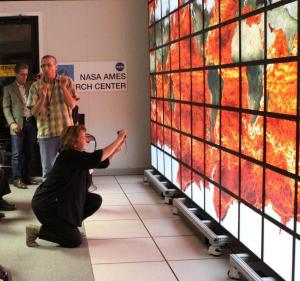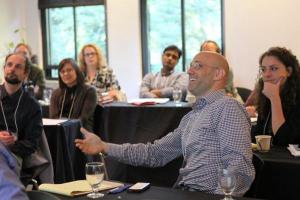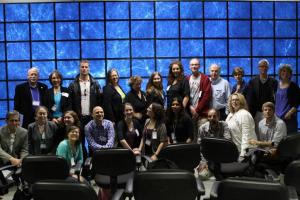By Trudy E. Bell
The idea was a natural. When, in June 2011, I became senior writer for the University of California High-Performance AstroComputing Center (UC-HiPACC), headquartered at UC Santa Cruz, I felt on a learning curve as steep as Mount Everest. Although for decades I had covered astronomy and the engineering of telescopes and detectors, I was still wrapping my head around the basics of supercomputing and its applications to astrophysics. Sure, high-end computation made analysis faster. I got that. But when I found that powerful computation is enabling realtime observational discovery (e.g., of supernovae exploding in other galaxies), and new theoretical insights (e.g., how the Milky Way got its spiral arms), and even turning cosmology into an experimental science (e.g., powerful enough to evolve the Universe all over again inside a supercomputer), I realized the revolutionary field of computational astronomy was a huge, under-told story that may have escaped others as well.I approached UC-HiPACC director Joel R. Primack with the idea for an intensive boot camp as a backgrounder in computational astronomy for science and engineering journalists in all media. Modeled loosely on the short, single-topic boot camps of the Knight Science Journalism program or the National Center for Atmospheric Research, ours would be the first on astronomy to be offered on the West Coast, and the first anywhere on computational astronomy.
Both Primack and UC-HiPACC seemed ideal as host and sponsor. Primack is distinguished professor of physics at UCSC and an architect of the cold dark matter theory now widely accepted as the standard model for the formation of the Universe. He had founded UC-HiPACC in 2010 with a five-year grant from the University of California to encourage collaborations — primarily through funding workshops, conferences, and travel grants — across UC campuses and three Department of Energy national laboratories (Lawrence Berkeley, Lawrence Livermore, and Los Alamos).
After consulting with Robert Irion, director of UCSC’s Science Communications Program, and Tim Stephens, UCSC public information officer who covers the campus’s scientific research, we titled the boot camp Computational Astronomy: From Planets to Cosmos. Faculty were invited from all UC campuses and the three affiliated DOE labs to serve as experts and speakers in intensive one-hour mini-courses designed convey essential background and highlight significant upcoming developments. Faculty were also asked to commit to staying at least the entire day of their presentations to give journalists informal time to establish relationships with potential sources.Faculty included Michael Norman, director of the San Diego Supercomputer Center, who offered insights as to why and how big supercomputers are enabling pioneering astrophysical research; James Bullock, director of the Center for Galaxy Evolution at UC Irvine, who outlined fundamental problems and approaches; and a dozen other key researchers (slides and videos of mini-courses are at hipacc.ucsc.edu/2012CAJBC_Program.html).
The program accepted 20 attendees (more than half were NASW members) from both general and scientific media. Journalists included staff and freelance feature writers for U.S. and international magazines, a daily newspaper reporter, new media specialists, an Emmy Award-winning documentary filmmaker, a radio reporter, and PIOs from two major universities; they ranged from blazing young talents to late-career veterans.
The boot camp was held June 24 to 27 and opened with a welcome reception at the home of Primack and his wife, philosopher and writer Nancy E. Abrams. Two days of formal sessions were held on the redwood-forested campus of UC Santa Cruz. Mini-courses covered current pioneering investigations in planetary science, stellar astronomy, explosive and high energy astrophysics, dark matter and dark energy, and cosmology, including discussions of instrumentation and analytical techniques.
One day included an on-campus field trip to the famous UC Observatories Instrument Laboratories and optical shops, plus an evening banquet. Another day concluded with a 90-minute journalism round-table discussion. There were also field trips to two institutions leading in astrocomputing and visualization: NASA Ames Research Center at Moffett Field in Mountain View, and the California Academy of Sciences in San Francisco.Participants were surveyed both at the conclusion of the boot camp and two months later in an effort to determine how useful the event had been to them. The following responses are representative:
“I did not know much about how computers are being used to produce new scientific insights and provoke searches for new phenomena. This was the probably the most important concept that I learned.”
“I will definitely get story ideas out of this — hopefully lead to new stories. But the overviews are very helpful to get deeper context about the research I cover — especially the mechanics of it, how simulations are made and what assumptions underlie them.”
“The workshop gave me rare and valuable time hanging out with astronomers informally, in small groups, and in a non-interview setting. I wish that could happen more often. It also gave me a good sense of some of the broad trends and big questions in astrocomputing.”
The faculty also found the boot camp eye-opening. One remarked: “To a scientist, the boot camp felt very different from a scientific meeting. First, the journalists actually ask questions. Second, some of the questions are scary to a scientist, such as ‘Why are you doing this experiment?’ Third, even though that’s the case, it is very important for scientists to hear their questions, especially since our work is publicly funded. Something like this boot camp should be held at the end of every scientific meeting!”
UC-HiPACC is evaluating the pros and cons of future boot camps on computational astronomy, including whether events should be tailored to other audiences such as education directors of science museums and planetariums, K-12 master teachers, or lower-division astronomy professors.
Meantime, journalists had no doubt there should be future boot camps in computational astronomy. As one remarked: “I think it is extremely useful to learn about the process, and how these scientists come about their findings.” Another declared: “Most definitely. This needs to go on. It is the best way to help journalists and scientists learn about so very different worlds and communicate science effectively.”
NASW members attending computational astronomy boot camp
- Rebecca Boyle, Popular Science
- Camille Carlisle, Sky & Telescope
- Charles Day, Physics Today
- Pam Frost Gorder, Research Communications, Ohio State University
- Heather Marie Goss, Air & Space/Smithsonian
- Lisa Grossman, New Scientist
- Donna Hesterman, Research Communications, University of Florida
- Earle M. Holland, Freelance writer
- Bruce Lieberman, Freelance Science & Environment Writer
- Angela Posada-Swafford, Muy Interesante
- Elizabeth Wilson, Chemical & Engineering News
Photos by Trudy E. Bell
Trudy E. Bell is senior writer at UC-HiPACC. She is a former editor for Scientific American and IEEE Spectrum magazines, is the author of a dozen books and nearly 500 articles on astronomy and other physical sciences, technology, history of science, and bicycling.






